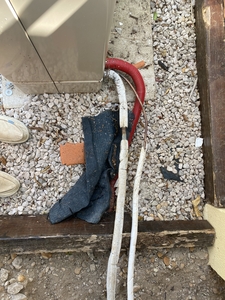Replacing Refrigerant on Mitsubishi Heat Pump
At last, I have found a contractor who is willing to, amongst other things, change the very bad primary pipework on my Mitsubishi ASHP - (PUHZ-SW120YHA + EHSC-VM2D Hydrobox).
(At least they have managed to convert my buffer tank to volumiser - Praise be!!)
However, so far they can get no information from Mitsubishi Portugal on the procedure for removal and refilling of the gas, presumably because they don't have many installations in Portugal, where Daikin seem to be, by far, the most popular.
I have done my own search and found some information in the Service Manual R410A No.OCH533, but I don't think it is enough.
It would be greatly appreciated if anyone could point me to something from Mitsubishi which specifically sets out the procedure.
Commercial aircon people would normally do this in the UK, I imagine same in Portugal. Does it actually need doing?
4kW peak of solar PV since 2011; EV and a 1930s house which has been partially renovated to improve its efficiency. 7kW Vaillant heat pump.
@jamespa The pipework was badly installed and even worse "insulated" by burying it. The rudimentary insulation has all but disappeared over the 3 years and it just does not stand up to comparison with best practice. The contractor is a reputable AirCon, HeatPump and other heating company, but they have little experience with Mitsu and what they have had was the difficulty now being experienced with Mitsu Portugal in extracting info.
Strange.
Very definitely in the UK there are two separate industries namely commercial aircon, who all have f-gas qualifications so can work with refrigerant, and domestic heat pumps, who don't. There is, strangely, little overlap. Mitsubishi aircon is very common in the UK, maybe not in Portugal?
4kW peak of solar PV since 2011; EV and a 1930s house which has been partially renovated to improve its efficiency. 7kW Vaillant heat pump.
@jamespa Mitsubishi aircon is fairly common here in the Algarve although Daikin leads and LG probably second. I suspect that Mitsu are more popular in the North as their main office is in Lisbon.
There has been less uptake of any manufacturer's heat pumps here, partly, but not entirely, due to the climate, but I would guess that Daikin are the most popular.
There does not appear to be the same separation of gas qualifications here as you describe, but this particular contractor was initially a fuel gas contractor. However, when a contractor brings along a man to check/ fill the gas you do not not know if he is actually employed by them or is freelance. The one used by this contractor looked competant and he did have an impressive range of gas equipment. I respect him not proceeding until he has the info, but I can tell stories of others that were astonishingly bad!
I wonder if @karl-r (who I refer to as Mr. AC UK 😉) would have any insights or advice.
Pre-order: The Ultimate Guide to Heat Pumps
Subscribe and follow our Homeowners’ Q&A heat pump podcast
@davidalgarve @editor you need to source a local air conditioning installer. The pipework and the technology is identical and Mitsubishi Electric in Portugal will have contacts for you if you need help. For piping and wiring the installation is the same as it is for their air conditioning units. If your pipe run is 10m or less then it is no more than the base charge. Following that the additional charge is 20 grammes per metre. Piperun should be greater than 2 metres. Please ensure that the person who does this holds the correct F-Gas certifications. However, if you want to prove the operation of the Heat Pump following this then you may need to get your heating installer there are the same time. In the UK these DX systems are less than 1% of the market. It differs throughout Europe. You may have local "Renewable" installers who very rarely get involved with DX systems such as yours.
@karl-r This is a local air conditioning installer, i.e. local to me in the Algarve, Portugal. The pipework will be a similar length to the existing installation, but will, hopefully be a rather better layout and certainly better insulated. What is needed is the Mitsubishi procedure for removal and refilling of the gas. The contractor is familiar with the procedure for other manufacturers. As I have reported, Mitsubishi Portugal are pretty useless and I wish I had known this before agreeing to this installation. UK is a different scene.
@davidalgarve it isn't a Mitsubishi procedure. It is the F-Gas procedure which is European Regulations. Mitsubishi cannot override that. Their manuals and all other manufacturers manuals state that installations should be as per the regions directives. If the installer does not know then you need to get another installer.
@davidalgarve Hi David, anyone - refrigeration or AC holding an F-gas licence can pump down, rework your pipework, pressure test, evacuate and release the refrigerants back into the circuits for you, any good engineer knowing the F-gas procedures could pick up the installation manual and re-commission the system one they had pumped down or remove the refrigerants for you. Karl is correct these units are used in only a select few places and are not common. Best is if you can fone a company out there like ours where they do both AC - air to air ASHP and ASHP - air to water, That way they know the F-gas and low temperature heating commissioning for ASHP's.
My advice would be not to ask Mitsubishi but to contact the nearest 5 AC or refrigeration companies and see who does them, another shout can be Pool ASHP companies although not exactly the same system the repairs on the refrigerant circuits would be the same.
Failing that you can export me out there for a week and just get a company with all the gear and no idea so I have some tools and refrigerant to fix it 🙂
Professional installer. Book a one-to-one consultation for pre- and post-installation advice, troubleshooting and system optimisation.
@ashp-bobba Thanks for your input. I stress that this contractor covers all manner of heating and cooling matters and I have more confidence in him than any of the many that I have come across here in the Algarve. You have hit the nail on the head when you say:"could pick up the installation manual and re-commission the system" I have many Mitsu manuals including the Service Manual I mentioned at the beginning (Service Manual R410A No.OCH533), but I (and the contractor) are not sure that this explains enough, i.e part of description reads:
10-1. Refrigerant collecting (pump down). When relocating or disposing of the indoor/outdoor unit, pump down the system following the procedure below so that no refrigerant is released into the atmosphere.
1 Turn off the power supply (circuit breaker).
2 Connect the low pressure valve on the gauge manifold to the charge plug (low pressure side) on the outdoor unit.
3 Close the liquid stop valve completely.
4 Supply power (circuit breaker).
• Even if power can be supplied, the pump down procedure cannot be completed depending on the unit's status. For more information, refer to the FTC Installation Manual or Service Manual.
• Startup of the indoor-outdoor communication takes about 3 minutes after the power (circuit breaker) is turned on. Start the
pump-down operation 3 to 4 minutes after the power (circuit breaker) is turned on.
5 Perform the refrigerant collecting operation (cooling test run).
• Push the pump-down SWP switch (push-button type) on the control board of the outdoor unit. The compressor and ventilators
(indoor and outdoor units) start operating (refrigerant collecting operation begins). (LED1 and LED2 on the control board of
the outdoor unit are lit.)
• Only push the pump-down SWP switch if the unit is stopped. However, even if the unit is stopped and the pump-down SWP
switch is pushed less than 3 minutes after the compressor stops, the refrigerant collecting operation cannot be performed.
Wait until the compressor has been stopped for 3 minutes and then push the pump-down SWP switch again.
6 Fully close the ball valve on the gas pipe side of the outdoor unit when the pressure gauge on the gauge manifold shows 0.05
to 0 MPa [Gauge] (approx. 0.5 to 0 kgf/cmÇ) and quickly stop the air conditioner.
• Since the unit automatically stops in about 3 minutes when the refrigerant collecting operation is completed (LED1 off, LED2
lit), be sure to quickly close the gas ball valve. However, if LED1 is lit, LED2 is off, and the unit is stopped, open the liquid
stop valve completely, close the valve completely after 3 minutes or more have passed, and then repeat step 5. (Open the
gas ball valve completely.)
I rather suggest that, if this is the appropriate description of the process, it is rather garbled and doesn't satisfactorily answer what condition the system should be in initially or explain the trigger which releases the gas to the collection equipment.
What I was seeking was a pointer to something (Mitsubishi Manual?) more intelligable than this.
I have found subsequently, another Mitsu manual which looks slightly better written:,
- but again I would feel happier to pass this on if I knew it was appropriate.
@davidalgarve Hi, I understood all of that, so these systems have a pump down (forced cooling mode) setting which allows for all of the LEV's to be in the correct position and force the compressor to run, by closing the manifold liquid line you can trap the refrigerant in the external HP unit performing a pump down, but I understand if it seems over complicated, there is good news and a way round all of this!
your contractor can just use a receiver cylinder (this is a clean reclaim cylinder) remove the gas using a reclaim machine (no need to run the heat pump or click any dip switches), complete the pipe changes and then after pressure test and evacuation just pump the same gas back in from that cylinder, this is F-gas compliant, filling out the paperwork to say gas was removed to make modifications and same gas placed back inside.
Professional installer. Book a one-to-one consultation for pre- and post-installation advice, troubleshooting and system optimisation.
- 26 Forums
- 2,118 Topics
- 46.5 K Posts
- 32 Online
- 4,522 Members
Join Us!
Latest Posts
-

RE: Heat Pump Books For Beginners – Bodge Buster & From Zero To Heat Pump Hero
@topher you’re more than welcome to, yes. I’ll send you...
By Mars , 9 hours ago
-

RE: Fitting new shower valve ..........
I’ve never taken a chance when fiddling and changing ou...
By Mars , 9 hours ago
-

RE: Help me keep the faith with my air source heat pump installation
@adamk what a shambles. Can you share some pics of the ...
By Mars , 9 hours ago
-
You should contact the council and report the unsatisfa...
By JamesPa , 13 hours ago
-
RE: Replacing Refrigerant on Mitsubishi Heat Pump
So the manual is correct and looks fine to me, to abbre...
By ASHP-BOBBA , 19 hours ago
-

RE: Benefits of an extra horizontal loop for GSHP
I would deffo install an additional slinky run, especia...
By Transparent , 20 hours ago
-
RE: Say hello and introduce yourself
@editor fab - thanks Mars, and keep up the great work o...
By normpang , 21 hours ago
-
RE: Compressor and Evaporator Stratification
@trebor12345 So I think the 1st zigzag section shows so...
By ASHP-BOBBA , 1 day ago
-

RE: Is this just haze or something more?
@majordennisbloodnok I was giving a talk to primary sch...
By Toodles , 2 days ago
-
RE: Tesla Powerwall – More of a ‘Luxury’ Than an ROI Winner!
We had our Tesla Powerwall 3 (and Gateway) installed ea...
By Old_Scientist , 2 days ago
-
Indeed. With a battery its presumably the battery con...
By JamesPa , 2 days ago
-
RE: No-code, plug-and-play monitoring for your heat pump
To update an ESP device using ESPHome in Home Assistant...
By Grantmethestrength , 3 days ago
-

RE: The good, the bad and the not that great – my heat pump installation
Said I would pop back with a update. Only Mr Jesus h...
By Burtis , 5 days ago
-
RE: Buffers, hot water and cooling
Thats presumably heat pump DT, what about radiator DT a...
By JamesPa , 5 days ago
-
RE: Who's your electricity provider and what's your tariff?
@chandykris Exactly the same here. We now have 13.5kWh ...
By Old_Scientist , 6 days ago
-
RE: Wood burner with ASHP - direct air?
This depends on the size of your wood burner and size/t...
By Lucia , 7 days ago
-
RE: Difficult positioning of air source heat pump
@rikiarn It's a not a buffer it's a volumiser which is ...
By Lucia , 7 days ago
-
RE: Is your heat pump insured?
To make things clear, lots of insurance companies cover...
By Lucia , 7 days ago
-
RE: Boxt Heat Pump Installation Experience
@adrian any updates since installation? How is it perfo...
By Ashfp , 7 days ago
-

@seatonian got your email. Will connect you with a reco...
By Mars , 1 week ago







